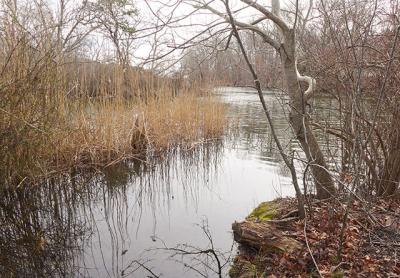Blame the Dogs: Road Runoff Pollutes Georgica Pond

Dogs and birds — not humans — are responsible for most of the fecal bacteria measured in Georgica Pond, with road runoff the primary source, according to a report from Stony Brook University’s School of Marine and Atmospheric Sciences.
The study, conducted by Christopher J. Gobler between May and November last year using DNA-based microbial tracking, quantified fecal bacteria at four tributary sites in the pond: Talmage Creek, Georgica Cove, Jones Creek, and Seabury Creek. Human-derived bacteria accounted for less than 5 percent of the total. Instead, results pointed to animal-derived bacteria — 67 percent from dogs, 24 percent from birds, and 6 percent from deer. The 67 percent attributed to dogs, according to the report, could include fecal bacteria from such species as cats and rodents.
East Hampton Town and Village officials, the town trustees, and the Friends of Georgica Pond Foundation, a group of pondfront property owners, are working to improve the ecological health of the pond, which has had toxic algae blooms in the last several summers, causing the State Department of Environmental Conservation to prohibit shellfishing. The foundation financed the study.
“The low levels of human fecal bacteria within the pond are both reassuring and somewhat expected,” the report states. “Wastewater traveling 100 to 400 feet in sandy aquifers experience a 12-order-of-magnitude reduction in fecal bacteria,” and most septic systems in the watershed are a greater distance from the pond. “Hence, it would seem that fecal bacteria emanating from household wastewater is retained within the sands of aquifers before it discharges into the pond via groundwater flow.”
That finding will have no effect on the Friends of Georgica Pond Foundation’s push for property owners to upgrade their septic systems to reduce nitrogen seepage, which is a factor in the algal blooms that prompted the trustees to close the pond for harvesting crabs and other marine life for parts of the last several summers.
“But we didn’t want to ignore stormwater runoff in the pond,” Sara Davison, the foundation’s executive director, said, “because there have been some very high readings.”
“Rather than emanating from household wastewater, there are multiple lines of evidence that indicate the main source of pathogenic bacteria to the major tributaries of Georgica Pond is runoff, especially from roads,” the report states. The highest levels of pathogenic bacteria were found in Talmage Creek, and the report suggests that runoff from Montauk Highway and surrounding roads drains directly into the creek via a low-lying rest area, taking animal waste with it.
“While there are many wild and domesticated animals in this region,” the report reads, “this specific area is also the only public pull-off area” on a long stretch of Montauk Highway, “and may be used to walk dogs during long drives from New York City to points on the South Fork, particularly during summer months.” The hypothesis is supported, it reads, by peak measurements of both enterococcus and dog-derived fecal bacteria in the creek during summer months.
Levels of fecal contamination in Talmage Creek are often higher than most other areas, as well as above the water quality criteria recommended by the Environmental Protection Agency and used by Suffolk County to issue swim advisories.
While not directly adjacent to Montauk Highway, Georgica Cove, in the southeastern section of the pond, receives drainage from a large section of Cove Hollow Road, which extends well north of the highway, the report states. “As is the case for Talmage Creek, this purposeful drainage of this large region likely leads to the collection and delivery of significant amounts of fecal bacteria to Georgica Cove.”
That road runoff is the primary source of fecal bacteria is further supported, the report states, by the lower level of dog-derived bacteria in Seabury and Jones Creeks, which are not directly adjacent to roads. Spikes in canine bacteria following rainfall further support the premise.
Jones Creek was shown to be unique among the sample sites, having higher levels of both bird and deer-derived bacteria, little dog-derived bacteria, and almost no human bacteria. The three other sites had similar distributions of bacteria, according to the report.
As Talmage Creek and Georgica Cove are the likely sources of bacteria in the rest of Georgica Pond, actions to divert runoff to these tributaries should lower fecal bacteria levels in the pond and its tributaries, the report states.
The report supports a push to redesign the rest area at Talmage Creek, Ms. Davison said, and members of the foundation have discussed the matter with town and State Department of Transportation officials. “The idea is to redesign the rest area so trucks could still pull off as needed, and perhaps create a better launching area, but re-pitch it and repave with pervious pavement so surface water runs through pavement instead of across it. Any opportunity to have stormwater percolate into the ground before it meets a water body is preferable to it washing right in,” she said.
Reducing direct discharge into the pond from a drainage pipe originating at Cove Hollow Road will also help, she said, and a plan to divert more water from the pipe along its course and install more filters to eliminate pathogens is underway.
Another result of the study, Ms. Davison said, is an education campaign aimed at pet owners. “People think if they walk their dog along the road they don’t have to pick it up, but you really should. Even if you’re a mile from the pond, a big, heavy rainfall can wash it in.”
Sampling will resume this summer, Ms. Davison said, including in the main body of the pond for comparison with its tributaries. But, she said, “the tributaries seem to be the main conduit for the runoff.”
